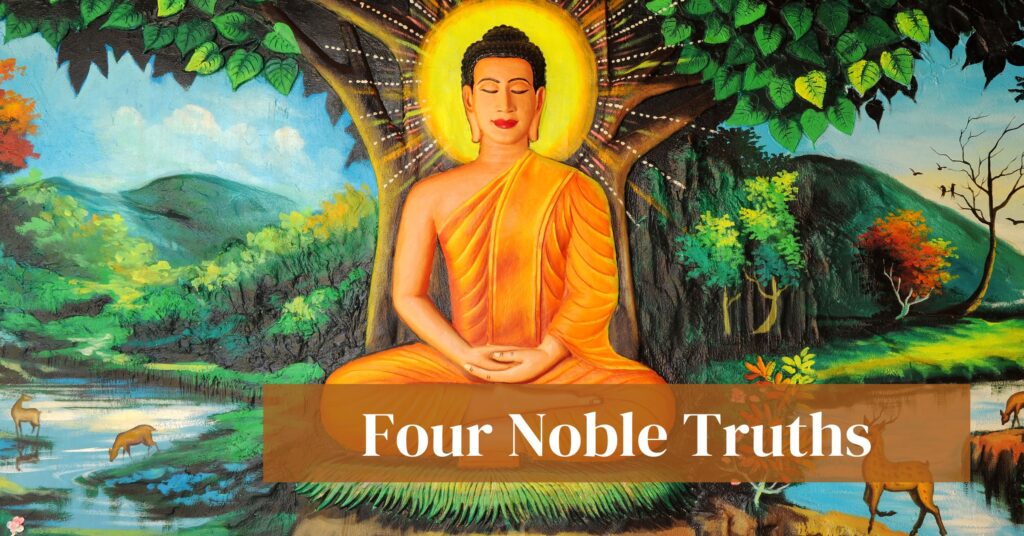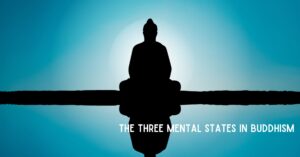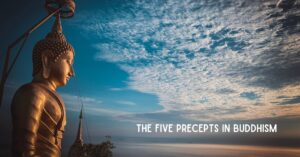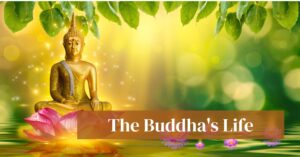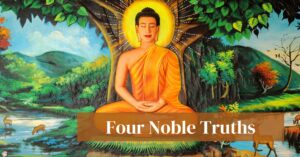The Four Noble Truths are the foundation of Buddhism and are considered the Buddha’s first teaching. The Four Noble Truths are:
- The truth of suffering (Dukkha): This truth acknowledges that suffering, or dissatisfaction, is an inherent part of life. The Dukkha includes physical and mental suffering, as well as the suffering that comes from change and impermanence.
- The truth of the cause of suffering (Samudaya): The cause of suffering is identified as craving and attachment to things, people, and experiences. This attachment can manifest in many forms, such as a craving for pleasure, material possessions, or even a sense of self.
- The truth of the cessation of suffering (Nirodha): The ending of suffering, or enlightenment, is possible through the elimination of craving and attachment. The Nirodhda can be achieved through the practice of the Eightfold Path.
- The truth of the Path leading to the cessation of suffering (Magga): The Eightfold Path is the Path that leads to the end of suffering. It consists of the right understanding, right intention, right speech, right action, right livelihood, right effort, right mindfulness, and right concentration.
The Four Noble Truths are not meant to be taken as separate entities but as an interrelated whole. They are intended to be understood together, and each truth depends on the other. The Four Noble Truths provide a framework for understanding the nature of suffering and the Path to its cessation. By understanding the Four Noble Truths, one can understand the nature of suffering and the Path to its end, leading to a more peaceful and fulfilled life.
Dukkha
In Buddhism, the term “dukkha” is often translated as “suffering” or “dissatisfaction.” It refers to the inherent suffering or unsatisfactoriness in all aspects of life. The Buddha taught that Dukkha is an inescapable part of the human experience and arises from our attachment to things, people, and experiences.
Dukkha can take many forms, including physical, mental, and suffering from change and impermanence. It includes the suffering of birth, aging, illness, death, and separation from loved ones. It also includes the misery of not getting what we want and the suffering of getting what we don’t want. Dukkha can be subtle, or it can be severe, but it is always present.
However, Buddhism teaches that Dukkha is not something that needs to be endured passively but can be overcome through the cultivation of wisdom and understanding of the Four Noble Truths, particularly the truth of the cessation of suffering (Nirodha). The Buddha taught that the ultimate goal of Buddhism is to understand the nature of Dukkha and to find a way to end it, leading to a more peaceful and fulfilled life.
Samudaya
In Buddhism, Samudaya is the second of the Four Noble Truths and refers to the cause of suffering. The word “Samudaya” can be translated as “arising together” or “origin,” and it relates to the origin of suffering.
The Buddha taught that the cause of suffering is craving and attachment to things, people, and experiences. Our desire for pleasure and our fear of pain drives these cravings and attachments. They manifest in many forms, such as a craving for material possessions, fame, power, or even a sense of self.
Our cravings and attachments lead us to cling to constantly changing things, such as our physical body, emotions, and thoughts. This clinging creates a sense of separation and alienation and leads to suffering.
Samudaya also refers to the cycle of rebirth, or samsara, where the suffering caused by craving and attachment leads to the formation of new karmic formations, leading to the cycle of rebirth. Samudaya is considered the cause of Dukkha and the cycle of rebirth. Still, also it is seen as the cause of the arising of the Five Aggregates, which form the basis of the individual experience.
The understanding of the nature of Samudaya is considered critical to the knowledge of the nature of suffering and the Path to its cessation. Through the cultivation of wisdom and understanding, it is possible to overcome the causes of suffering and attain enlightenment.
Nirodha
In Buddhism, Nirodha is the third of the Four Noble Truths and refers to the cessation of suffering. The word “Nirodha” can be translated as “cessation,” “extinction,” or “ending.” It refers to the state of enlightenment or liberation, where suffering is brought to an end.
The Buddha taught that the ultimate goal of Buddhism is to understand the nature of suffering and to find a way to end it. He taught that the cessation of grief could be achieved by eliminating the causes of suffering, which are craving and attachment, through the cultivation of wisdom and understanding.
Nirodha is the state of mind free from craving and attachment, characterized by peace, stability, and inner freedom. It is a state of consciousness beyond the cycle of rebirth and suffering, considered to be the ultimate goal of Buddhism. The attainment of Nirodha is called Nirvana, which is the ultimate goal of Buddhism.
The attainment of Nirodha is not seen as a final destination but rather a state of mind that can be cultivated through the practice of the Eightfold Path, which leads to the development of wisdom and understanding, leading to the elimination of craving and attachment, and the attainment of a state of inner peace and freedom. The Buddha taught that the Path to Nirodha is a gradual process that requires patience, perseverance, and a commitment to practice.
Magga
In Buddhism, Magga is the fourth of the Four Noble Truths and refers to the Path leading to the cessation of suffering. The word “Magga” can be translated as “path” or “way.” It relates to the Path that leads to the attainment of enlightenment or liberation, where suffering is brought to an end.
The Buddha taught that the Path to the cessation of suffering is the Eightfold Path, which consists of the right understanding, right intention, right speech, right action, right livelihood, right effort, right mindfulness, and right concentration. The Eightfold Path is a practical guide for achieving enlightenment and is considered the middle way between the extremes of self-indulgence and self-mortification.
The Eightfold Path is not a linear process but a spiral one, where each step builds on the previous one and leads to the next. It is an ongoing process of self-improvement and development, and one can continue to progress along the Path throughout their lifetime. The Eightfold Path is not only for monks or nuns but for laypeople too, and it is meant to be integrated into daily life.
The Eightfold Path is not a set of beliefs to be accepted on faith but a path to be followed through experience and experimentation. The Path is aimed at cultivating wisdom, ethical conduct, and mental discipline. The Eightfold Path is meant to be followed to develop insight and understanding, eliminate craving and attachment, and attain inner peace and freedom.
